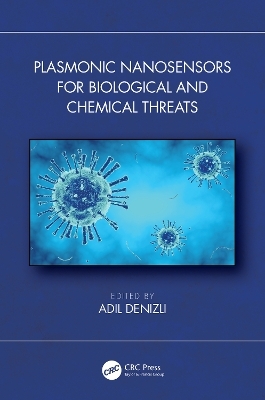
Plasmonic Nanosensors for Biological and Chemical Threats
CRC Press (Verlag)
978-1-032-60474-9 (ISBN)
Biological and chemical warfare agents, including viruses, bacteria, and explosive and radioactive compounds, can induce illness or death in humans, animals, and plants. Plasmonic nanosensors as detection tools of these agents offer significant advantages, including rapid detection, sensitivity, selectivity, and portability. This book explores novel and updated research on different types of plasmonic nanosensors for analysis of biological and chemical threat agents. It covers a brief theory of plasmonic nanosensors, summarizes the state-of-art in the molecular recognition of biological and chemical threat agents, and describes the application of various types of nanosensors in the detection of these threat agents.
This book:
Brings together recent academic research from an interdisciplinary approach including chemistry, biology, and nanotechnology
Discusses current trends and developments
Describes applications of a variety of different types of plasmonic nanosensors
Explores outlooks and expectations for this technology
Showcasing the latest achievements in plasmonic nanosensors, this book will appeal to researchers in materials, chemical, and environmental engineering as well as chemistry interested in exploring the application of sensors to support environmental monitoring and global health.
Adil Denizli is Professor of the Department of Chemistry and Head of the Division of Biochemistry at Hacettepe University, Turkey.
1. Introduction of biological and chemical threat agents. 2. The Key Concepts of Plasmonic Nanosensors. 3. Plasmonic nanosensors for biological and chemical threat agents detection. 4. Synthetic Biology Applications for Biosensing of Biological and Chemical Threats. 5. Microfluidic-Based Plasmonic Nanosensors for Biological and Chemical Threats. 6. Surface enhanced Raman spectroscopy-based plasmonic nanosensors for the detection of threats. 7. Surface Plasmon Resonance Nanosensors for Sensing of Bacterial Threats. 8. Plasmonic Nanosensors for Real-time Detection of Nerve Agents. 9. Flurometric Sensing of Chemical threats agents via Plasmonic nanoparticles. 10. Sensing of Chemical and Biological Threats by using Molecular Imprinting-Based Plasmonic Nanosensor Platforms. 11. Detection of Chemical and Biological Threat Agents using Nanomaterials-based Plasmonic Nanosensors. 12. Plasmonic sensors based on molecularly imprinted polymers for detection of biological and chemical threats. 13. Explosive Detection Using Plasmonic Nanosensors. 14. COVID-19 Detection with Plasmonic Nanosensors. 15. Other Analytical Methods for Detection of Biological and Chemical Threats.
| Erscheinungsdatum | 25.04.2024 |
|---|---|
| Zusatzinfo | 18 Tables, black and white; 37 Line drawings, black and white; 24 Halftones, black and white; 61 Illustrations, black and white |
| Verlagsort | London |
| Sprache | englisch |
| Maße | 156 x 234 mm |
| Gewicht | 802 g |
| Themenwelt | Medizin / Pharmazie ► Physiotherapie / Ergotherapie ► Orthopädie |
| Naturwissenschaften ► Chemie ► Technische Chemie | |
| Technik ► Medizintechnik | |
| Technik ► Umwelttechnik / Biotechnologie | |
| ISBN-10 | 1-032-60474-3 / 1032604743 |
| ISBN-13 | 978-1-032-60474-9 / 9781032604749 |
| Zustand | Neuware |
| Informationen gemäß Produktsicherheitsverordnung (GPSR) | |
| Haben Sie eine Frage zum Produkt? |
aus dem Bereich


